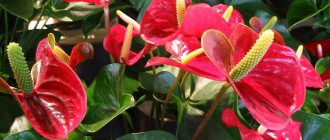Loading…
Loading…
The types and varieties of primrose amaze with their diversity and shades of buds. These are unique flowers that bloom in early spring, bringing with them the approach of warmth and sunny days, delighting with their bright colors. Currently, researchers are actively working on developing more and more new varieties, of which more than 500 are currently known. Primrose can be grown not only in a personal plot, but also in an apartment, where it can form flowers all year round. Which cannot but please housewives.
Types and varieties of powdery primroses
Powdery primroses include about 90 species. Their characteristic feature is the presence of a coating in the form of white dust. The flowers typically come in shades of purple, white, yellow and lilac, with the calyx protruding beyond the petals.
In order for a flower bed with primroses to bloom every year, you need to periodically plant flowers.
The most common types are:
- Siberian primrose. This type of plant grows in steppe meadows and forests. It reaches a height of 27 cm, primrose leaves rapidly taper towards the bottom. The flowers are colored deep pink. Several buds form an umbrella-shaped inflorescence. Flowering occurs in early summer and lasts about three weeks. The plant reproduces by seeds. With proper care, the Siberian species lives for several years.

- Scottish primrose. This is also a powdery primrose that can be found on alpine hills. The plant develops well at low air humidity. It is better to feed the flower with mineral fertilizers, periodically adding them to the soil.
Alpine primroses
Grown in rock gardens and alpine houses, these compact forms usually do not exceed 15 cm in height. Single or grouped flowers usually bloom in spring - early summer. Their limbs are flat, saucer-shaped or, less often, more bell-shaped, with a diameter of up to 2 cm. European and Asian species differ in their requirements for growing conditions. In the middle zone, winter hardiness varies. What is important is not even winter temperature drops, but rather loose snow cover. Without snow, primroses freeze out, and under the thick crust of crust they dry out during the winter.
P. allionii (P. Allioni)
A dense cushion of winter-green foliage is covered in the first half of spring with flowers 1.5-3 cm in diameter. Corollas of different shades from pink to purple with white eyes or white. The leaves are sticky, fleshy, spatulate to rounded, up to 4 cm long. This is one of the most popular indoor alpines, growing naturally on the shady cliffs of the Maritime Alps. Many varieties and hybrids have been developed.
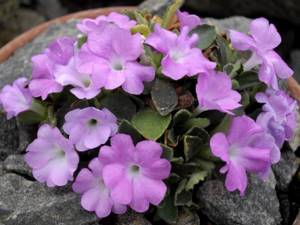
Dense cushion of winter-green foliage
All of them require very careful handling: they cannot tolerate water getting on the shoots, especially in winter, and suffer from gray rot (botrydia) if all dying leaves are not carefully removed.
The height and diameter of the plants is 5x20 cm.
"Anna Griffith"
A slow-growing groundcover variety with pastel lavender-pink flowers, the edge of which is fringed.
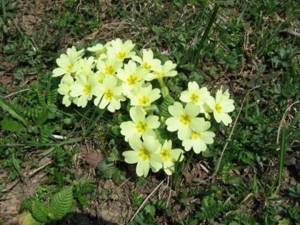
Slow growing ground cover variety
"Austen"
This variety grows slowly and has purple corollas.
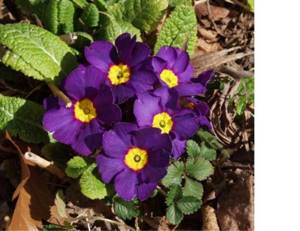
Corollas purple
"Avalanche"
The flowers are large, creamy white.
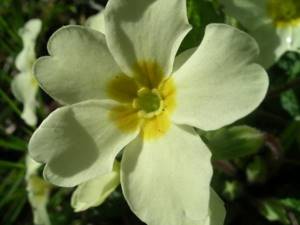
The flowers are large, creamy white
"Crowsley Variety"
Small leaves and very dark purple-red corollas with a white eye.
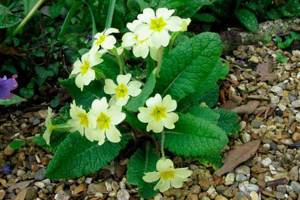
Small leaves
“Ken's Seedling” (syn. “KRW”)
A powerful variety with large lilac-violet flowers, the limbs of which are deeply notched.
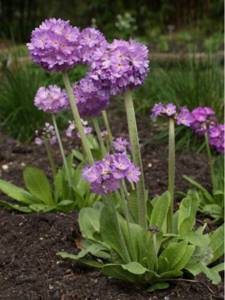
Powerful variety with large lilac-violet flowers
P. auricula (P. auricula, P. auricula)
The ancestor of one of the classes of garden primroses. From mid-spring to early summer it produces umbels of bright yellow funnel-shaped flowers with a white powdery eye. The leaves are leathery, winter-green, pointed, up to 12 cm long, serrated or entire, with or without a powdery coating. In nature, the species is distributed from the French Alps to the Tatras. Good soil type, characterized by sufficient drought and frost resistance. Grows successfully in the middle zone. The height and diameter of the plant is 15x15cm.
Section OREOPHLOMIS
This group includes perennial primroses. The flowers of such plants grow small or medium. You can usually see them in early spring. The buds are pink with a yellow tint. The leaves are serrated and smooth.
Pink primrose also belongs to this section. The flower stalks of this species reach a length of 13-15 cm. The buds appear in May, and the leaves begin to set only after all the flowers have bloomed. Most often found on marshy soils, propagation is carried out by seeds or by dividing the bush.
Reproduction, planting and care
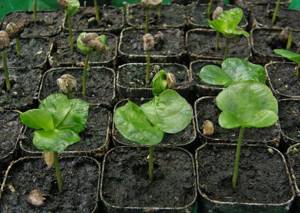
The perennial propagates by seeds and by dividing the bush. In the first case, it can be sown in a pot or directly in open ground. There are three favorable periods for this - at the end of winter, in the middle of summer, and at the end of autumn. The site is preferable without direct sunlight, the soil is light, loamy. You can use a “temporary flowerbed” and then plant the plant in a permanent place. It is worth paying attention that different varieties of primroses differ in their requirements for cultivation. The bush is divided 3-5 years after the plant has bloomed; this is done at the end of summer. The transplanted plant is watered regularly and provided with frost protection for the winter.
The gentle harbingers of spring are unpretentious. The plant prefers shade or partial shade, moist, breathable soil. High-quality drainage is the key to a healthy flower. Primrose loves replanting; some gardeners do it once a year. The crop is fed 4-5 times: twice at the beginning of spring, in the middle and at the end of summer. Weeding from weeds is systematically necessary, at the same time it is advisable to loosen the soil. The area under the plant is covered with a new nutrient layer of soil every year.
Auricular section
This section includes more than 20 species. The main place of growth is the lands of Europe. As a rule, these are low bushes that produce purple, lilac flowers with a yellow or white core.
The following varieties are often found:
- Hairy primrose. This is a variety bred from the auricular primrose, which can have any color of the flower. It also includes English primroses (white center, stripes extending from the center, there is a powdery coating), Belgian primroses (two-color and single-color buds without plaque), as well as terry ones.
- Primula aurica. This plant is resistant to cold weather, thrives in the shade and in the sun, and develops quickly in fertile, moist soil. It is very important for the plant to get enough calcium. Found naturally in England. The leaves of the plant have denticles, the flowers are often yellow, but other shades are also found.
Cortus primula section
This section contains more than 20 species. The flowers of the plant are funnel-shaped, they do not have a powdery coating, and the leaves have petioles. If the soil is fertile, then primrose will grow equally well both in sunlight and in shady areas.
Primrose cortusiformes
This species is most common throughout Eurasia. A distinctive feature is the horizontal short rhizome. The leaves have denticles and grow on thin petioles. The flowers grow from umbrella-shaped inflorescences. Each has several purple-red buds. The flowers are characterized by having a deep groove in the middle. Their diameter is 1.5 cm. The buds usually bloom in late spring or early summer.
Primrose siebold
These flowers grow down, up or to the side. They have a special color and bud shape. When bloomed, they can be pink, lavender, dark red, white, or purple.
Some primrose siebold flowers are two-colored: the inside and outside have a different shade.
Primrose rejected
The height of this perennial flower reaches 35-40 cm. Primrose grows well in a short period of time due to its well-developed root system. The leaves reach 8-10 cm in length, have the shape of an ellipse, the base is equipped with a weak core. Flowers are located on thin and low-lying stems.
Garden primrose
This plant is popularly called ram plant for its wrinkled, wavy leaves that are covered with hairs. There is also an original name - keys, because the natural yellow and white castings of flowers look like keys. I love this primrose very much, and I am happy to plant it on the site of my country house.
There are five main groups of garden species. These primroses differ from each other in the shape of the inflorescences, their location on short peduncles, which are located above the leaves. This is a cushion primrose, distinguished by the beauty of its flowers, densely arranged in a floral rosette.

Umbrella-shaped primroses are very impressive, the flowers of which are collected on a high peduncle, reminiscent of a one-sided or round umbrella. This plant has subspecies - rejected, pink, spring, auricular, which can diversify any flower garden. The spherical representatives of this family, which have received the second name capitates, look beautiful. They have dense spherical inflorescences located on strong stems.
During flowering, flower stalks shoot out arrows up to 15-20 cm in height, and grow further until the seed boxes ripen. By this time, their length can reach 30-40 cm.

Fine-toothed primrose also has this feature, and these two tall species can be advantageously located in a flowerbed composition among low-growing plants. Candelabra primroses or tiered ones look stylish. Their peculiarity is that the inflorescences are arranged on long peduncles in such a way that they resemble ancient candelabra. These include the subspecies Bisa, Bulley, and Japanese.
There are varieties called bell-shaped. Their flowers are located on peduncles of different heights with drooping heads, very similar to bells. They have their own names - Sikkimese and Florinda.
But the simplest one is the common primrose, which develops the fastest, since it has retained most of the natural qualities inherent in its forest relative. Dense inflorescences of white, yellow, pinkish flowers form a dense cap.
Based on this species, breeders have developed a large number of hybrid forms with simple and double flowers in purple, yellow, and blue shades.

Section of toothed primroses
This includes those types of primroses in which the flowers form a large inflorescence. The most popular representative is the toothed primrose. In nature it can be seen in China. There is also a white coating on the plant. The leaves are light in color. Flowers appear on long stalks reaching 22-24 cm. Lilac, white, purple buds bloom in April. Flowering lasts a little over a month. They tolerate cold well and reproduce by seeds. They grow equally well in the sun and in the shade.
Section muscarioides
This includes almost 20 species of primroses, the inflorescences of which are shaped like sharp cylinders. These varieties are common in Asia. In winter, the plant needs to be covered, and during the growing season it should be watered frequently and a lot.
Primrose vial
This plant is perennial, quite tall (reaches half a meter in height). The inflorescences resemble spikelets, the flowers have a pink-lilac hue. The leaves are bright green, slightly wrinkled. Primula viala blooms in mid-summer. This process continues for a little over a month. Does best in loose, moist, fertile soil in sun or partial shade. For the winter, the plant needs to be well covered.
Section of candelabra primroses
This group includes about 30 species. Such plants are distinguished by long peduncles that appear in the summer months. In order for the bushes to germinate quickly in the spring and delight you with their flowering as early as possible, they need to be covered with special agrofibre for the winter. You can see what the primroses from the candelabra section look like in the photo.
In the sun, primus flowers can lose their shade.
The most popular varieties of this group:
- Japanese primrose. The birthplace of this flower is Japan. It can also be found on the Kuril Islands. Compared to other varieties, Japanese primrose has a peduncle about 50 cm high. The buds are arranged in tiers. When loosened, they can acquire a crimson or snow-white hue. This primrose develops well on fertile soils in partial shade.
- Primrose powdered. This type is the most decorative among the candelabra section. In nature, the flower grows in the marshy areas of China. This species differs from others in the white coating that covers the entire peduncle. A small amount can also be observed on the leaves.
Also included in this section is Primrose bullea. This is a biennial, which, with proper care, can be a perennial. The flowers of this primrose are orange in color with a yellowish tint. All of them are collected in large inflorescences on a peduncle of about 50 cm. You can see the flowering from June to July.
Primrose propagation
Dividing the bush is the most suitable way to propagate primrose. It is carried out after flowering in 3-4 year old plants. Before dividing the bush, it is necessary to water it, then dig it up and divide it into several parts so that each part has a root lobe and several leaves.
Then the plants are planted at a distance of 15-20 cm from each other on the prepared area. Reproduction can also be carried out by seeds, sowing in late autumn. In this case, flowering will occur in the second year after sowing.
It is necessary to sow in bowls on the surface of sandy deciduous soil. Primrose seeds are not embedded in the soil, but are covered with film or glass. By protecting the crops from the sun, sunrises will appear in 3 weeks. Primrose sown in summer blooms in winter, and primrose sown in winter blooms in autumn.

Other types of primroses
Primula florinda is very popular among primroses. This is one of the large flowers. Peduncles reach more than a meter in height. At their top there are flowing umbrellas. They are created from many buds that are shaped like a bell. They often take on a yellowish-orange hue. In nature, such primrose grows near bodies of water. This is due to the fact that the flower loves moisture very much. Therefore, to grow primroses at home, you need to maintain abundant watering and high air humidity.
Primula rubra
No less popular is primrose rubra. It is often called fine-toothed. The plant is distinguished by the unusual shape of its inflorescences. In this primrose they are spherical. The buds are small. When opened, they can be burgundy, white, or red. The inflorescences are located on a light green peduncle. Initially, it does not exceed 3 centimeters, but by the middle of flowering it already reaches 25 cm.
Primula pallas
Primrose pallas is a medium flowering variety. The buds bloom in early May. Flowering duration is about a month. Often the flowers are yellow. Like other species, they are collected in inflorescences. Leaf plates are located near the root system. In nature, Pallas primrose grows up to 30 centimeters tall.
Primrose sikkim
Also worth mentioning is the Sikkimese primrose. This species is distinguished by drooping flowers of a beige or light yellow hue. The peduncle is not tall. In an adult plant it reaches 15 cm. The leaves are small. Their length does not exceed 2 cm. All of them are lanceolate and abundantly covered with a powdery coating on top. Often the plates are slightly swollen near the base. Bushes prefer to grow only in moist soil.
Scandinavian primrose
Scandinavian primrose has graceful shapes. The plant reaches a maximum of 30 cm. The leaves of this primrose reach 9 cm in length. It is distinguished by simple flowers that can acquire a reddish-pink or purple hue. The buds are small. They are collected in inflorescences resembling an umbrella. Each of them can have up to 12 buds.
Primula florinda
The most powerful plant is Primula florinda. Its homeland is the lands of Tibet. The flower will grow up to 1.2 meters tall. The width of the bush does not exceed 90 cm. The leaves of this species are quite long. Their size reaches 45 cm. The flowers are tubular-shaped, white, pink or cream.
If you want your flowerbed to play with different colors throughout the summer, then primroses are what you need. By choosing the right varieties, you will certainly achieve the desired result.
Diseases and pests
Primroses are considered resistant to various diseases and parasites, but are not immune from them. Common primroses may suffer more than others.
Important! If the primrose withers, then the first thing to do is adjust the watering.
The most common diseases are:
- Gray rot - develops on flowers and leaves, manifests itself in the form of an unpleasant coating and rotting. The reason is excess moisture and oversaturation of the earth with nitrogen. Infected leaves are cut off, and the bush itself is sprayed with copper oxychloride.
- Ramulariasis – this is the first reason why the leaves turn yellow. Lemon-colored spots appear on the plates, and their lower side becomes covered with a specific coating. Spraying with copper-containing preparations gives good results. Copper oxychloride will also be effective.
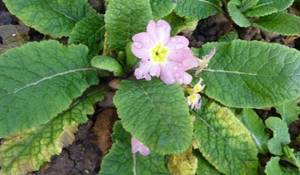
- Powdery mildew - brown spots form on the leaves simultaneously with plaque. The cause is excessive moisture at moderate temperatures. Bordeaux mixture or copper-containing preparations will come to the rescue. A severely damaged plant will have to be thrown away.
To avoid the appearance of caterpillars and mites, mother plants should be inspected regularly . If the damage is minor, a solution of soap with 72% fatty acids and alkali (household) or mineral oil will help. If the process is advanced, it is recommended to resort to chemical agents (FUfanon, Iskra-M, Fitoferm, Akarin).
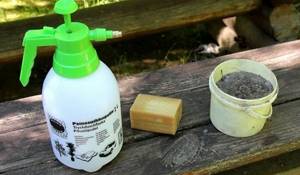
Replanting after purchase, irrigation, and fertilizing are important components of flower care. Therefore, if you want to grow a beautiful specimen, you should follow the basic rules.








